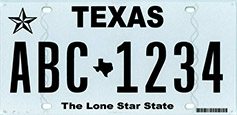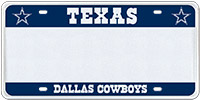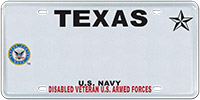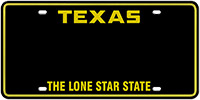 What Is a License Plate Reader and Can Police Track You Using It?
What Is a License Plate Reader and Can Police Track You Using It?
Table of Contents
- Texas License Plates
- Texas License Plate Design and Formats
- Texas Vanity License Plate
- Most Popular Texas Special Plate Numbers
- Texas License Plate Lookup
- What Do I Need to Get a License Plate in Texas?
- Differences Between a Passenger License Plate and a Commercial License Plate in Texas
- How to Renew License Plate in Texas
- How to Transfer a License Plate in Texas
- Texas License Plate Lookup Frequently Asked Questions (FAQ)
 Texas License Plates
Texas License Plates
Texas license plates are metal plates affixed to motor vehicles in the state to serve as an official means for identifying these vehicles and their registered owners. These license plates are currently issued by the Texas Department of Motor Vehicles (TxDMV), and they display a unique combination of numbers and letters (a license plate number) that links the vehicle to its owner. Per the Texas Transportation Code, any motor vehicle that operates or is driven in Texas must display two valid license plates: one on the front and another on the rear. However, motorcycles, trailers, semitrailers, road tractors, and antique cars are typically issued a single license plate, usually displayed on the rear.
The TxDMV offers vehicle owners several types of license plates catering to various preferences, interests, and eligibility criteria. These include:
- General-issue License Plates: these are the standard plates issued when you register your vehicle with the TxDMV. These plates cannot be personalized.
- Specialty License Plates: these plates let you add a personal touch to your vehicle. The TxDMV offers two main kinds of specialty license plates: non-qualifying specialty plates, which anyone can order, and qualifying specialty plates, which can only be ordered by individuals who meet specific eligibility criteria. Most specialty license plates can be personalized.
- Digital License Plates: these kinds of plates are only issued to vehicles that meet the following criteria:
- Are not classified as passenger vehicles
- Are part of a commercial fleet with at least 25 non-apportioned motor vehicles, semitrailers, or trailers used for business purposes by a corporation, partnership, limited liability company, or similar entity
- Are owned or operated by a governmental entity.
- Souvenir License Plates: these plates are typically purchased as gifts, mementos, or decorations; they cannot be displayed on vehicles. Many specialty license plates are also available as souvenir plates.
Note that the TxDMV typically issues a registration insignia (also known as a registration sticker) when you register your vehicle and for each subsequent registration renewal. This insignia displays your license plate number, county of registration and partial vehicle identification number and must be attached to the inside of your windshield at the lower left corner in a way that does not obstruct your vision when driving. If the vehicle does not have a windshield, you must inform the department when applying for registration or renewal so that they can provide a distinctive device to attach to its rear license plate in place of this insignia.
 Texas License Plate Design and Formats
Texas License Plate Design and Formats
Texas license plates are rectangular-shaped, reflectorized aluminum plates that prominently feature a unique alpha-numeric combination known as the license plate number. The design of general-issue license plates (Texas's standard plates) has evolved over the years since the state began issuing them in 1917. The current design, known as the "Texas Classic" plate, was introduced in July 2012 and features a minimalistic design consisting of black lettering over a white sheeting background with double security thread in the sheeting. The seven-character plate number displayed follows an "ABC-1234" serial format, with an image of the state acting as a separator. The words "TEXAS" and "The Lone Star State" are centered at the top and bottom of the plate, respectively, with a black and white five-pointed star screened at the top left corner.
Be aware that this design is for general-issue plates; specialty license plates have different designs and formats, often including logos and emblems of the cause or organization associated with the plate.
Here are pictorial examples of Texas license plate designs:
General-issue license plates:

Specialty license plates:




* Source: Texas Department of Motor Vehicles
 Texas Vanity License Plate
Texas Vanity License Plate
In Texas, a vanity plate is a license plate that displays a combination of letters and numbers you select yourself instead of a license number assigned by the TxDMV. Most specialty license plates the department offers can be personalized to display a desired plate number configuration that reflects your opinions and personality or shares a message.
You can check the availability of your desired personalization online through TxDMV's plate marketing vendor's website; you can also create and order a personalized plate design via this platform. Orders can also be placed by submitting an Application for Specialty License Plate, along with any required attachments and stipulated fees, to your local county tax office. Personalized plate numbers may be up to seven characters and can include spaces and symbols, such as hyphens, periods, hearts, stars, or silhouettes of the State of Texas; the specific character count per plate varies by plate type and design. Note that the TxDMV may decline your personalization for certain reasons, such as:
- It conflicts with a current or proposed regular license plate numbering system
- It is considered objectionable. This includes configurations that are derogatory, vulgar, have sexual connotations, reference gangs or controlled substances, and mimic law enforcement or government agencies
The TxDMV typically sends an email notification once your plates are shipped to your local county tax office; this office will also notify you once the plates arrive. Personalized plates are typically issued for one, three, or five years, and they will be automatically canceled unless you renew them within 60 days of their expiration. You will be charged a personalization fee in addition to regular registration and specialty plate fees; total costs vary depending on your desired plate type, category, validity period, and local administrative fees.
For additional assistance regarding your personalized plates, contact your county tax office. Inquiries can also be directed to the TxDMV's Special Plates Unit at (512) 374-5010.
 Most Popular Texas Special Plate Numbers
Most Popular Texas Special Plate Numbers
There are over 400 specialty plate themes and designs available in Texas. Some of the most popular specialty plate themes and designs requested by vehicle owners across the state include:
- Be a Blood Donor
- Carbon Fiber
- Classic Black
- Dallas Cowboys
- Disabled Veteran
- Houston Astros
- Lone Star Black
- San Antonio Spurs
- Share the Road Y'all
- Small Star Black
- Take Care of Texas
- Texas A&M University
- Texas Music
- Texas Parks and Wildlife
- Texas Tech University
- Texas Trails
- University of Texas
- Wildflowers
 Texas License Plate Lookup
Texas License Plate Lookup
A license plate lookup is a process through which you can access information about a vehicle using its plate number. This lookup typically provides information like the vehicle's make, model, year of manufacture, registration status, accident history, and inspection records. License plate lookups are commonly used for investigative and law enforcement purposes. They can also be utilized to verify a vehicle's history before purchasing.
You can access vehicle information in Texas by submitting a Request for Texas Motor Vehicle Information (Form VTR-275) to the state's Department of Motor Vehicles via mail or in person at any of its Regional Service Centers. You must specify the type of information needed and include a copy of your ID, supporting documentation (where necessary), and stipulated fees.
You can also access vehicle information by performing a reverse license plate number search on RecordsFinder and other similar third-party websites that offer these services. Depending on the website and scope of your search, you may be able to access some of the information for free; however, you will typically be charged a nominal fee for a comprehensive vehicle report.
Be aware that, per federal and state regulations, you cannot access another vehicle owner's personal information, like their name, photograph, and address without the person's written authorization, except for specific reasons (as permitted by the Texas Motor Vehicle Records Disclosure Act).
Texas Reverse License Plate Number Search
You can obtain vehicle-related information online using license plate lookups and reverse license plate number searches. However, these two processes use slightly different methodologies to retrieve this information. A license plate lookup typically requires inputting a plate number into a search tool to obtain information on the linked vehicle. On the other hand, reverse license plate number searches use partial details about a vehicle to retrieve more substantial information, including associated license plate numbers.
You can perform reverse license plate number searches on Texas-registered vehicles through several third-party websites, with RecordsFinder being a prominent and trusted option. However, per the Texas Motor Vehicle Records Disclosure Act, you may not be able to access personal information like a vehicle owner's name, number, and address, through these searches.
 What Do I Need to Get a License Plate in Texas?
What Do I Need to Get a License Plate in Texas?
The Texas Department of Motor Vehicles assigns license plates to registered vehicles in the state. The department typically does this through local county tax offices. You must register your vehicle within 30 days of moving to Texas or purchasing a new vehicle; otherwise, you may face late registration penalties. Texas dealers are responsible for handling this process on behalf of their customers; they must do so within the 30-day timeframe (45 days for seller-financed purchases). You can file a complaint with the TXDMV if your dealer fails to provide your title, registration, or both (where applicable) within the stipulated timeframe.
For private-party purchases or new Texas residents, you must first obtain adequate insurance coverage and get your vehicle inspected by a certified Vehicle Inspection Station. Be aware that you will be required to provide proof of your vehicle insurance during the inspection. Once you have completed these steps, you can apply for your registration by submitting the following documents at your local county tax office:
- A completed Application for Texas Title and/or Registration (Form 130-U)
- The vehicle's old title or out-of-state registration receipt, where applicable
- Proof of current vehicle insurance
- Proof of current Texas vehicle inspection
- A government-issued photo ID
Note that your county tax office may request additional documents depending on your particular circumstances. It is also advisable to contact this office beforehand for exact fee amounts and acceptable payment methods. These fees are typically determined by your vehicle type, its purchase value, applicable state and local taxes, and other administrative costs. Once your application is processed and fees are paid, you'll receive your license plates and registration insignia, either in person at the county tax office or through the mail, depending on the county's procedures.
You can direct questions on vehicle titling, registration, and license plate issuance to your county tax office or by calling the TxDMV at 1-888-368-4689 or (512) 465-3000.
 Differences Between a Passenger License Plate and a Commercial License Plate in Texas
Differences Between a Passenger License Plate and a Commercial License Plate in Texas
Under Texas law, any vehicle used to transport people and designed to carry a maximum of 10 people (including the driver) is considered a passenger car. On the other hand, commercial motor vehicles are vehicles designed or primarily used to transport property. This includes passenger cars reconstructed and mainly used for delivery purposes. However, passenger cars used to deliver US mail, motorcycles, and mopeds are not considered commercial vehicles. The TxDMV typically assigns general-issue license plates to both passenger and commercial vehicles; however, commercial vehicles weighing over 10,000 pounds are typically assigned a license plate indicating the vehicle type or weight class.
The table below summarizes the key differences between passenger license plates and commercial license plates in Texas:
| Features | Passenger License Plate | Commercial License Plate |
|---|---|---|
| Vehicle Use/Type |
|
|
| Plate number arrangement |
* alpha-numeric combination for specialty plates may be less than seven characters |
|
| Design & Color |
Black lettering over a white sheeting design with double security thread in the sheeting. Image of the state acting as plate number separator. The words "TEXAS" and "The Lone Star State" are centered at the top and bottom of the plate, with a black and white five-pointed star screened at the top left corner. * this design is for regular-issue plates. Specialty plates typically feature varying designs based on representing themes and organizations |
Same as passenger plates, with vehicle type added just below "TEXAS" |
| Use Limitations | None | Commercial use only |
| Requirements for obtaining |
* county tax office may request additional documents |
Same as passenger license plates |
 How to Renew License Plate in Texas
How to Renew License Plate in Texas
You must renew your vehicle's registration with the Texas Department of Revenue annually – this renewal also revalidates your license plates. Your registration expiration date is the last day of the month indicated on your registration insignia (sticker). Note that even though specialty plates are typically valid for the original term purchased (one, five, or ten years for specialty plates purchased before the 1st of December, 2014, and one, three, or five years if ordered on or after this date), you must still renew your registration annually. The TxDMV usually sends out renewal notices to registrants before their registration expiration date. Nevertheless, you are responsible for ensuring that your plates are renewed before they expire; otherwise, you can face citations and other penalties.
The TxDMV allows for early renewals up to 90 days before your registration expiration date. You must first get a vehicle inspection before initiating the renewal process. This inspection should be done at any certified Vehicle Inspection Station in your county of residence no earlier than 90 days before your registration is set to expire. After your vehicle passes the inspection, you can then renew your plate via any of the following methods:
- Online renewals using either the TxDMV's registration renewal portal (you will need to provide your plate number and the last four digits of your VIN to access this portal) or the Texas by Texas (TxT) mobile app. Be aware that you cannot utilize online renewal options if you have received an expired registration citation if your registration has been expired for more than 12 months (even without a citation), or if there is a hold on your registration due to certain unpaid fines, fees, or taxes. In these situations, the renewal must be done in person at your county tax office. The TxDMV advises waiting at least 24 hours after your vehicle passes its inspection before initiating a registration renewal online
- County tax office renewals. You can renew your registration in person through your county tax office; some county tax offices also offer a mail-in renewal option. You will typically be required to submit the following documents:
- Your renewal notice. If you don't have this, you may submit either your VIN, plate number, or previous year's registration receipt
- A copy of your Vehicle Inspection Report
- Proof of current vehicle insurance
- A valid government-issued photo ID
- Stipulated fees (as indicated in your renewal notice)
Some counties authorize participating grocery stores and other approved locations to perform registration renewals on their behalf. The requirements for renewing through these alternative locations are generally the same as when you renew at the county tax office, except that you must go along with your renewal notice. Some locations may also not be able to verify your vehicle inspection manually with a VIR; in these situations, you will be directed to your county tax office to complete the renewal process
Renewal fees vary by location and are determined by factors like your vehicle type, plate type, and renewal method – your chosen method also influences the renewal processing time. You will typically be issued a receipt that can be used as temporary registration until your new registration insignia is delivered; this usually takes up to two weeks for online renewals.
 How to Transfer a License Plate in Texas
How to Transfer a License Plate in Texas
The TxDMV permits vehicle owners to transfer license plates between vehicles at no cost. Note that general-issue license plates can only be transferred between passenger cars and trucks weighing one ton or less. Antique, classic, custom vehicle, and street rod specialty license plates cannot be transferred.
You can transfer your plates under the following circumstances:
- Between vehicles you own. You must contact your county tax office to get a new registration insignia for the vehicle the plates are being transferred to
- When you buy a vehicle from a private seller. You must register the transferred plates with your county tax office when you get the vehicle titled in your name
- When you buy a vehicle from a dealer. You can remove the plates from your old vehicle and ask the dealer to transfer them to the new one
- From a jointly titled vehicle to one in your name only. However, you can only do this if your name hasn't changed
- To a vehicle that you are leasing
When you transfer your plates, ensure that you remove your registration insignia from the windshield of the old vehicle. You can contact your county tax office for assistance in initiating the transfer process.
 Texas License Plate Lookup Frequently Asked Questions (FAQ)
Texas License Plate Lookup Frequently Asked Questions (FAQ)
Can I Find the Owner of a License Plate in Texas?
The Texas Motor Vehicle Records Disclosure Act (modeled after the federal Driver's Privacy Protection Act) prohibits the TxDMV from sharing vehicle owners' personal information without their authorization. This personal information includes, but is not limited to, the individual's name, address, telephone number, and photograph or computerized image. However, this act makes exemptions for specific situations where this information may be disclosed without the owner's consent, such as for law enforcement investigations, legal proceedings, and insurance claims investigations.
Therefore, unless you are qualified to access personal information contained in motor vehicle records as state law provides, you cannot find the owner of a license plate in Texas. If you have a pressing need to do this, consider seeking assistance from your local law enforcement agency.
Notwithstanding this, you can still access non-personal vehicle information on over 269 million registered vehicles nationwide through websites like RecordsFinder using either a license plate number or vehicle identification number (VIN).
Can I Get a Replacement for My Lost License Plate in Texas?
You can get a replacement for lost Texas license plates by submitting an Application for Replacement License Plates and/or Registration Sticker (Form VTR-60) to your county tax office. You will be charged a non-refundable $6.50 fee for this replacement. Replacement plates are typically processed and mailed within three weeks. Contact your county tax office for available submission options and location-specific requirements.
What Do Police See When They Run Your License Plates in Texas?
In Texas, police officers and other law enforcement officials can typically access personal and non-personal information on a vehicle and its registered owner when they run license plates. These include:
- The vehicle's registration status
- Details about the car, like its make, model, and year of manufacture
- The registered owner's name, picture, address, and license status
- Stolen vehicle alerts, BOLOs, and other similar alerts
- Driving violations, open warrants, and other related information on the registered owner
Can I Search License Plates for Free in Texas?
Texans often use free license plate search services to look up details on vehicles they intend to purchase, review the vehicle's history, and ensure it's not being sold with a cloned VIN.
You can conveniently perform these free license plate searches online through third-party websites that offer reverse license plate number searches for Texas-registered vehicles, like RecordsFinder. Free license plate searches typically provide information like the vehicle's make, model, and year of manufacture, tank size, engine type, body style, VIN, and price.
What Is the Penalty for Driving with an Expired License Plate in Texas?
License plates are typically renewed annually alongside your vehicle's registration. However, some specialty license plates may have validity periods of three, five, or ten years (the renewal notice you get on the year of these plates' expiration will include a reminder to renew them). Note that you must renew your vehicle registration annually, even if you use specialty plates with validity periods longer than one year.
Driving with expired registration or license plates in Texas is punishable by a fine of up to $200. You may be given a grace period of up to five working days after your registration expires before being fined for driving with expired license plates. You can also be fined for failing to display a current registration insignia on your windshield more than five working days after your vehicle's registration expiration. In addition, the TxDMV may impose late renewal penalties, which typically increase the longer you wait to renew your plates; in extreme cases, your vehicle can be impounded. Lastly, your specialty plates will be canceled and become available to anyone if you fail to renew them within 60 days of expiration.
Do I Need to Return License Plates in Texas?
The TxDMV does not require vehicle owners to return license plates. However, if you sell or dispose of a vehicle and do not wish to transfer the plates to another vehicle, it is advisable to surrender them to your county tax office for proper disposal. Doing this absolves you from liabilities if the plates get lost or stolen and are subsequently used fraudulently or for criminal activities.
Can I Keep My Texas License Plate If I Move to Another State?
Texas license plates typically belong to the vehicle owner and are yours to keep if you move out of state. However, if you decide to dispose of them, it is advisable to deface the front of the plate with permanent ink, cut them into pieces, or use any other method that will prevent them from being reused fraudulently.
What Size Are License Plates in Texas?
Texas license plates are typically 12 inches by 6 inches (the same standardized size utilized for passenger license plates across the county). However, motorcycle plates are usually 7 inches by 4 inches.
How Long Can You Drive with Temporary License Plates in Texas?
The TxDMV issues temporary permits that allow vehicle owners without valid registration or license plates to operate their vehicles legally. These temporary permits are available for different situations and include:
- 72-Hour/144-Hour Permits: these are typically issued for commercial laden trucks, truck-tractors, trailers, semitrailers, or motor buses to travel on Texas highways. They may be used to operate unregistered commercial vehicles and buses in Texas and for intrastate operations with an out-of-state licensed commercial vehicle. Note that a valid USDOT number is required to obtain either permit
- One-Trip Permits: these are valid for 15 days from the effective date and are typically issued for unladen vehicles. As the name implies, these permits can only be used for a single journey from the point of origin to the destination and any intermediate points listed on the receipt issued. Note that the trip's starting or ending point must be within Texas
- 30-Day Permits: these permits are issued for noncommercial vehicles, such as passenger cars, motorcycles, and private buses, as well as commercial vehicles that do not weigh more than 10,000 lbs (they may be issued for commercial vehicles exceeding this weight if they are operating unladen). 30-day permits are not issued for vehicles that will not be used in Texas and can be obtained up to 60 days before their effective date
- Vehicle Transit Permits: these permits let you drive a newly purchased vehicle home or to your local county tax office if the seller keeps the Texas license plates. Vehicle transit permits are valid for five days and cover one trip between the origin, destination, and any stops noted on the permit. Note that these permits are only available for passenger cars weighing 6,000 pounds or less and light trucks with a gross vehicle weight of 10,000 pounds or less. Only one permit is allowed per vehicle
Driving with an expired temporary permit is an offense punishable by a statutory fine of $200. Violators may also face additional TxDMV-imposed sanctions.
What Are the Steps to Renew a License Plate in Texas?
Here are the steps to take to renew your Texas license plates with the TxDMV:
- Confirm your renewal due date. This is typically the last day of the month indicated on your registration insignia (sticker). The TxDMV also usually sends a renewal notice before this date
- Get your vehicle inspected at a certified Vehicle Inspection Station (in your county of residence). You can do this inspection up to 90 days before your registration expiration date
- Choose a renewal method. The TxDMV offers several renewal options, including online renewals via a web portal and mobile app and in-person renewals at your county tax office or a county-approved third-party location. Note that your vehicle must pass its inspection before initiating the renewal
- Receive your new registration insignia (sticker) and attach it to your windshield at the lower left corner (on the inside). You may be issued a temporary receipt to use as proof of your renewal until your insignia arrives
What Do I Do If My License Plate Is Lost or Stolen in Texas?
Contact your county tax office for a replacement if your Texas license plates get lost or stolen. You will typically be required to complete an Application for Replacement License Plates and/or Registration Sticker (Form VTR-60) and pay a $6.50 fee. Reporting the lost or stolen plates to your local law enforcement agency is also advisable.
 Related Articles
Related Articles
The information on this website is taken from records made available by state and local law enforcement departments, courts, city and town halls, and other public and private sources. You may be shocked by the information found in your search reports. Please search responsibly.
Recordsfinder.com is not a “consumer reporting agency” and does not supply “consumer reports” as those terms are defined by the Fair Credit Reporting Act (FCRA). Pursuant to our Terms of Service and Privacy Policy, you acknowledge and agree not to use any information gathered through Recordsfinder.com for any purpose under the FCRA, including but not limited to evaluating eligibility for personal credit, insurance, employment, or tenancy.
Searches of license plate and VIN information are available only for purposes authorized by the Driver’s Privacy Protection Act of 1994 (DPPA).
By clicking “I Agree” you consent to our Terms of Service, agree not to use the information provided by Recordsfinder.com for any unlawful purposes, and you understand that we cannot confirm that information provided below is accurate or complete.
The search you are about to conduct on this website is a people search to find initial results of the search subject. You understand that any search reports offered from this website will only be generated with the purchase of the report or account registration.



